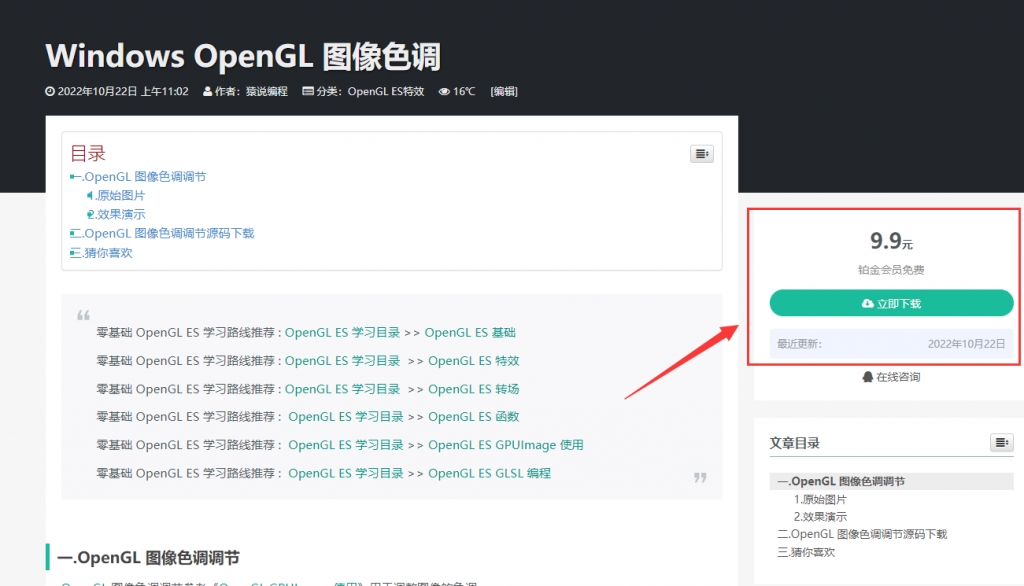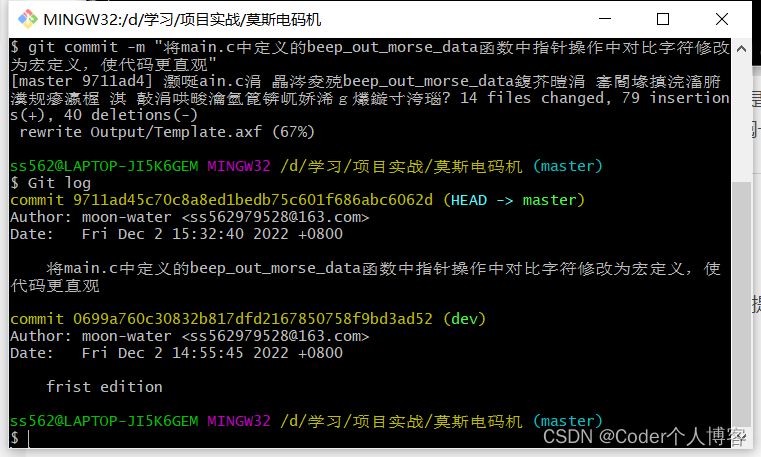一、wait notify
1. 小故事 - 为什么需要 wait
2. 原理之 wait / notify
(1)Owner 线程发现条件不满足,调用 wait 方法,即可进入 WaitSet 变为 WAITING 状态。
(2)BLOCKED 和WAITING 的线程都处于阻塞状态,不占用 CPU 时间片。
(3)BLOCKED 线程会在 Owner 线程释放锁时唤醒。
(4)WAITING 线程 会在 Owner 线程调用 notify 或 notifyAll 时唤醒,但唤醒后并不意味着立刻获得锁,仍需要进入 EntryList 重新竞争。
3. API 介绍
(1)obj.wait():让进入 Object 监视器的线程到 waitSet 等待
(2)obj.notify():在 Object 上正在 waitSet 等待的线程中挑一个唤醒
(3)obj.notifyAll():让 Object 上正在 waitSet 等待的线程中全部唤醒
它们都是线程之间进行协作的手段,都属于 Object 对象的方法。 必须获得此对象的锁 ,才能调用这几个方法
wait() 方法会释放对象的锁,进入 WaitSet 等待区,从而让其他线程就机会获取对象的锁。无限制等待,直到 notify 为止
wait(long n) 有时限的等待 , 到 n 毫秒后结束等待,或是被 notify
二、wait notify 的正确姿势
1. sleep(long n) 和 wait(long n) 的区别
(1)sleep 是 Thread 方法,而 wait 是 Object 的方法
(2)sleep不需要强制和 synchronized 配合使用,但 wait 需要
(3)sleep在睡眠的同时不会释放锁,但 wait 在等待的时候会释放锁对象
(4)它们状态 TIMED_WAITING
2. 正确姿势
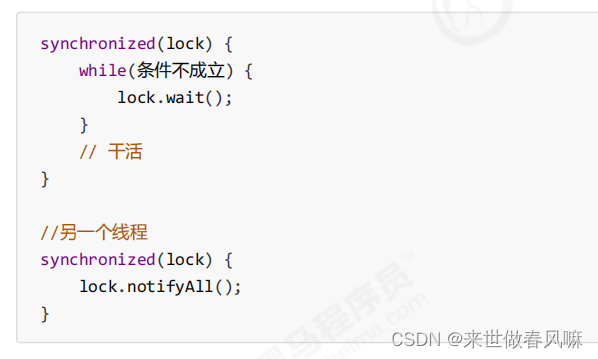
3. 同步模式之保护性暂停
3.1 定义
即 Guarded Suspension,用在一个线程等待另一个线程的执行结果。
要点:
(1)有一个结果需要从一个线程传递到了另一个线程,让它们关联同一个 GuardedObject。
(2)如果有结果不断从一个线程到另一个线程那么可以使用消息队列(见生产者/消费者)。
(3)JDK 中,join 的实现、Future 的实现,采用的就是此模式。
(4)因为要等待另一方的结果,因此归类到同步模式。
3.2 实现
@Slf4j(topic = "c.Test20")
public class Test20 {
public static void main(String[] args) throws InterruptedException {
GuardedObject guardedObject = new GuardedObject();
new Thread(()->{
log.debug("等待结果");
ArrayList<Integer> list = (ArrayList<Integer>) guardedObject.get();
log.debug("结果大小:{}",list.size());
},"t1").start();
new Thread(()->{
log.debug("执行下载");
try {
Thread.sleep(3000);
} catch (InterruptedException e) {
e.printStackTrace();
}
ArrayList<Integer> list = new ArrayList<>();
list.add(1);
list.add(1);
list.add(1);
guardedObject.complete(list);
},"t2").start();
}
}
class GuardedObject {
// 结果
private Object response;
// 获取结果
public Object get() {
synchronized (this) {
while (response == null){
try {
this.wait();
} catch (InterruptedException e) {
e.printStackTrace();
}
}
return response;
}
}
// 产生结果
public void complete(Object response) {
synchronized (this) {
// 给结果成员变量赋值
this.response = response;
this.notifyAll();
}
}
}3.3 带超时版 GuardedObject
@Slf4j(topic = "c.Test20")
public class Test20 {
public static void main(String[] args) throws InterruptedException {
GuardedObject guardedObject = new GuardedObject();
new Thread(()->{
log.debug("等待结果");
ArrayList<Integer> list = (ArrayList<Integer>) guardedObject.get(2000);
log.debug("结果是:{}",list);
},"t1").start();
new Thread(()->{
log.debug("执行下载");
try {
Thread.sleep(3000);
} catch (InterruptedException e) {
e.printStackTrace();
}
ArrayList<Integer> list = new ArrayList<>();
list.add(1);
list.add(1);
list.add(1);
guardedObject.complete(list);
},"t2").start();
}
}
// 增加超时效果
class GuardedObject {
// 结果
private Object response;
// 获取结果
// timeout 表示要等待多久 2000
public Object get(long timeout) {
synchronized (this) {
// 开始时间 15:00:00
long begin = System.currentTimeMillis();
// 经历的时间
long passedTime = 0;
while (response == null) {
// 这一轮循环应该等待的时间
long waitTime = timeout - passedTime;
// 经历的时间超过了最大等待时间时,退出循环
if (timeout - passedTime <= 0) {
break;
}
try {
this.wait(waitTime); // 虚假唤醒 15:00:01
} catch (InterruptedException e) {
e.printStackTrace();
}
// 求得经历时间
passedTime = System.currentTimeMillis() - begin; // 15:00:02 1s
}
return response;
}
}
// 产生结果
public void complete(Object response) {
synchronized (this) {
// 给结果成员变量赋值
this.response = response;
this.notifyAll();
}
}
}3.4 原理之 join
是调用者轮询检查线程 alive 状态
t1.join();等价于
synchronized (t1) { // 调用者线程进入 t1 的 waitSet 等待, 直到 t1 运行结束 while (t1.isAlive()) { t1.wait(0); } }
join 体现的是【保护性暂停】模式
3.5 多任务版 GuardedObject
图中 Futures 就好比居民楼一层的信箱(每个信箱有房间编号),左侧的 t0 , t2 , t4 就好比等待邮件的居民,右侧的 t1 , t3 , t5 就好比邮递员如果需要在多个类之间使用 GuardedObject 对象,作为参数传递不是很方便,因此设计一个用来解耦的中间类, 这样不仅能够解耦【结果等待者】和【结果生产者】,还能够同时支持多个任务的管理
(1)新增 id 用来标识 Guarded Object
// 增加超时效果 class GuardedObject { // 标识 Guarded Object private int id; public GuardedObject(int id) { this.id = id; } public int getId() { return id; } // 结果 private Object response; // 获取结果 // timeout 表示要等待多久 2000 public Object get(long timeout) { synchronized (this) { // 开始时间 15:00:00 long begin = System.currentTimeMillis(); // 经历的时间 long passedTime = 0; while (response == null) { // 这一轮循环应该等待的时间 long waitTime = timeout - passedTime; // 经历的时间超过了最大等待时间时,退出循环 if (timeout - passedTime <= 0) { break; } try { this.wait(waitTime); // 虚假唤醒 15:00:01 } catch (InterruptedException e) { e.printStackTrace(); } // 求得经历时间 passedTime = System.currentTimeMillis() - begin; // 15:00:02 1s } return response; } } // 产生结果 public void complete(Object response) { synchronized (this) { // 给结果成员变量赋值 this.response = response; this.notifyAll(); } } }
(2)中间解耦类class Mailboxes { private static Map<Integer, GuardedObject> boxes = new Hashtable<>(); private static int id = 1; // 产生唯一 id private static synchronized int generateId() { return id++; } public static GuardedObject getGuardedObject(int id) { return boxes.remove(id); } public static GuardedObject createGuardedObject() { GuardedObject go = new GuardedObject(generateId()); boxes.put(go.getId(), go); return go; } public static Set<Integer> getIds() { return boxes.keySet(); } }
(3)业务相关类@Slf4j(topic = "c.People") class People extends Thread{ @Override public void run() { // 收信 GuardedObject guardedObject = Mailboxes.createGuardedObject(); log.debug("开始收信 id:{}", guardedObject.getId()); Object mail = guardedObject.get(5000); log.debug("收到信 id:{}, 内容:{}", guardedObject.getId(), mail); } } @Slf4j(topic = "c.Postman") class Postman extends Thread { private int id; private String mail; public Postman(int id, String mail) { this.id = id; this.mail = mail; } @Override public void run() { GuardedObject guardedObject = Mailboxes.getGuardedObject(id); log.debug("送信 id:{}, 内容:{}", id, mail); guardedObject.complete(mail); } }
(4)测试
@Slf4j(topic = "c.Test20") public class Test20 { public static void main(String[] args) throws InterruptedException { for (int i = 0; i < 3; i++) { new People().start(); } Sleeper.sleep(1); for (Integer id : Mailboxes.getIds()) { new Postman(id, "内容" + id).start(); } } }
4. 异步模式之生产者消费者
4.1 定义
(1)与前面的保护性暂停中的 GuardObject 不同,不需要产生结果和消费结果的线程一一对应
(2)消费队列可以用来平衡生产和消费的线程资源
(3)生产者仅负责产生结果数据,不关系数据该如何处理,而消费者专心处理结果数据。
(4)消息队列是有容量限制的,满时不会再加入数据,空时不会再消耗数据
(5)JDK 中各种阻塞队列,采用的就是这种模式
4.2 实现
@Slf4j(topic = "c.Test21") public class Test21 { public static void main(String[] args) { MessageQueue queue = new MessageQueue(2); for (int i = 0; i < 3; i++) { int id = i; new Thread(() -> { queue.put(new Message(id , "值"+id)); }, "生产者" + i).start(); } new Thread(() -> { while(true) { sleep(1); Message message = queue.take(); } }, "消费者").start(); } } // 消息队列类 , java 线程之间通信 @Slf4j(topic = "c.MessageQueue") class MessageQueue { // 消息的队列集合 private LinkedList<Message> list = new LinkedList<>(); // 队列容量 private int capcity; public MessageQueue(int capcity) { this.capcity = capcity; } // 获取消息 public Message take() { // 检查队列是否为空 synchronized (list) { while(list.isEmpty()) { try { log.debug("队列为空, 消费者线程等待"); list.wait(); } catch (InterruptedException e) { e.printStackTrace(); } } // 从队列头部获取消息并返回 Message message = list.removeFirst(); log.debug("已消费消息 {}", message); list.notifyAll(); return message; } } // 存入消息 public void put(Message message) { synchronized (list) { // 检查对象是否已满 while(list.size() == capcity) { try { log.debug("队列已满, 生产者线程等待"); list.wait(); } catch (InterruptedException e) { e.printStackTrace(); } } // 将消息加入队列尾部 list.addLast(message); log.debug("已生产消息 {}", message); list.notifyAll(); } } } final class Message { private int id; private Object value; public Message(int id, Object value) { this.id = id; this.value = value; } public int getId() { return id; } public Object getValue() { return value; } @Override public String toString() { return "Message{" + "id=" + id + ", value=" + value + '}'; } }



![[附源码]计算机毕业设计springboot线上社区管理系统](https://img-blog.csdnimg.cn/4e19cc37c6d14d19b87513ca6fb167d7.png)








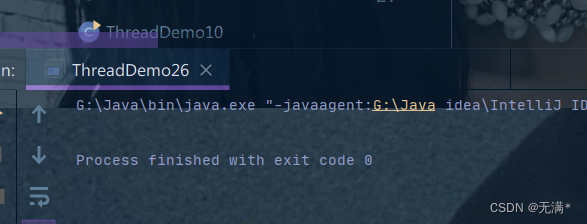
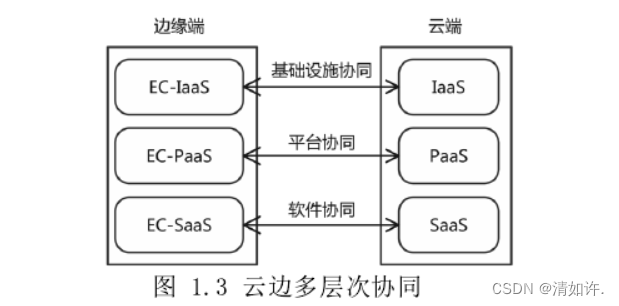
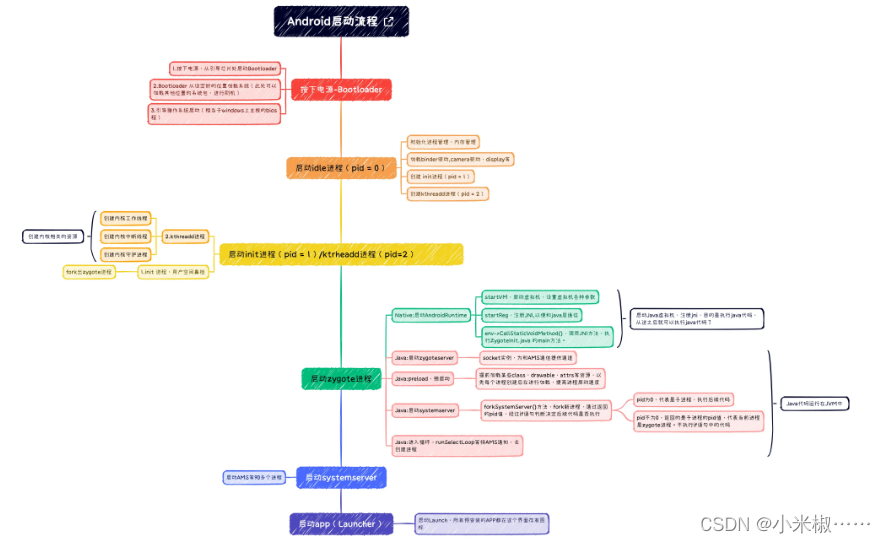

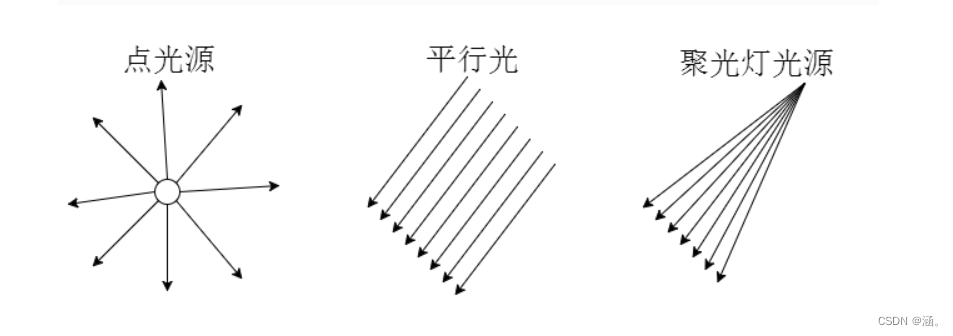
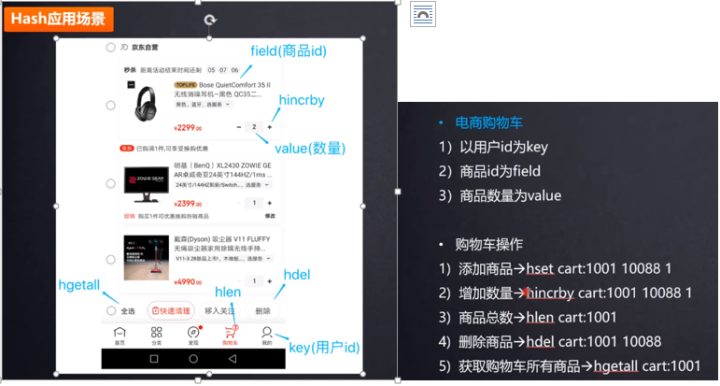
![B2B电子商务策略[在2022年发展您的业务]](https://img-blog.csdnimg.cn/img_convert/f5ca9d04ab8b2d6193f4b5256b8976ff.png)
